#ancient cosmology
Text


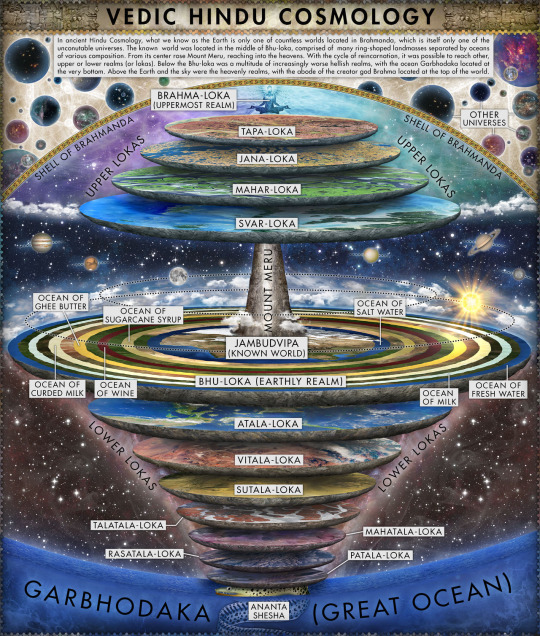

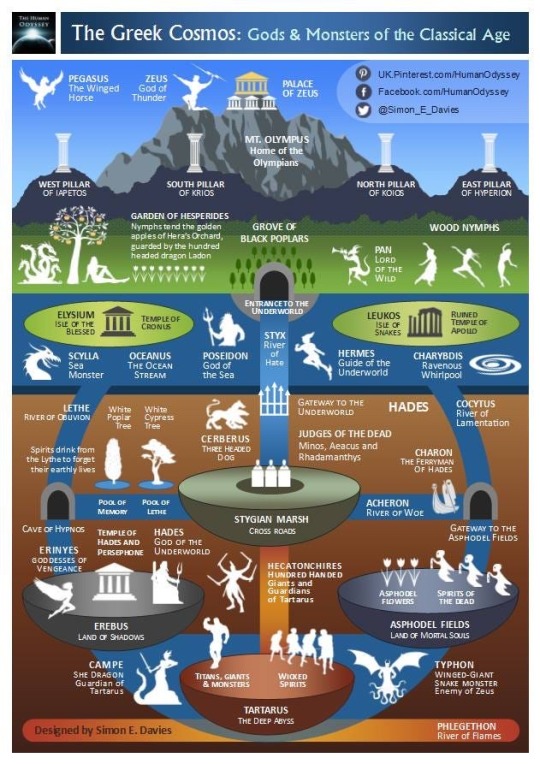

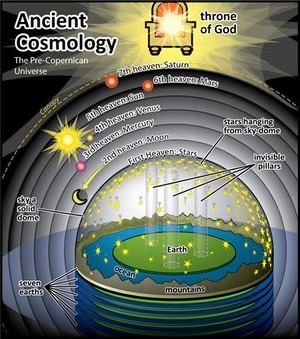
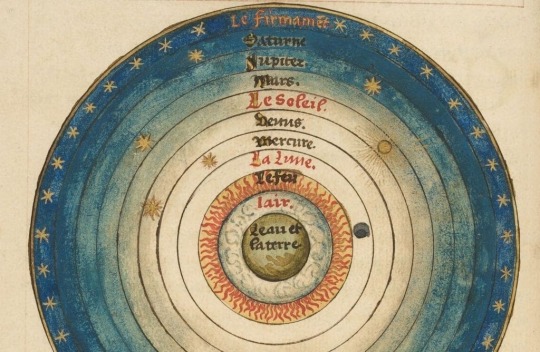


Cosmology
Both ancient and modern.
#Sumerian#Egyptian#Hindu#Hebrew#Greek#Norse#Islam#Scholastic#the Big Bang#the known Universe#cosmology#ancient cosmology#modern cosmology#religion#myth#mythology#science#Sumerian Cosmology#Egyptian Cosmology#Hindu Cosmology#Hebrew Cosmology#Greek Cosmology#Norse Cosmology#Islamic Cosmology#Pre-Copernican Cosmology#Scholastic Cosmology#scientific Cosmology
36 notes
·
View notes
Text
"Enchanting Echoes of Mesopotamia: Unveiling Mystical Realms in Myths & Legends of Babylonia & Assyria"
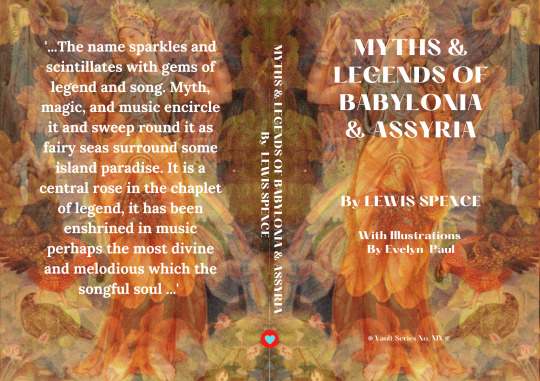
Lewis Spence's "Myths & Legends of Babylonia & Assyria" transcends time, beckoning readers into the rich tapestry of ancient Mesopotamian cultures with the enchanting grace of Evelyn Paul's illustrations. Spence, a luminary in mythological studies, skillfully navigates the complexities of Babylonian and Assyrian mythologies, breathing life into forgotten gods, heroes, and cosmic sagas. The book is a mesmerizing journey through the Euphrates and Tigris valleys, where the divine and mortal coalesce in tales of creation, epic battles, and profound wisdom.
Spence's narrative prowess shines as he unravels the intricate threads of these myths, exploring the divine pantheon with scholarly precision and a storyteller's finesse. Each page is adorned with Evelyn Paul's evocative illustrations, transporting readers to the mystical landscapes of ancient cities and sacred temples. The synergy between text and art elevates the reading experience, making the myths palpable and the legends vivid.

(Image from the book: Assur-nazir-pal attended by a Winged Mythological Being.—Bas-relief from the north-western palace at Nimrûd.—Photo W. A. Mansell and Co.)
From the creation epic Enuma Elish to the heroic exploits of Gilgamesh, Spence masterfully distills the essence of each myth, offering readers a gateway to understanding the spiritual and cultural tapestry of ancient Mesopotamia. The book becomes not just a collection of stories but a portal to another era, where gods walked among mortals, and the cosmos held secrets waiting to be unveiled.
In "Myths & Legends of Babylonia & Assyria," Spence beckons readers to delve into the heart of Mesopotamian cosmology, where chaos and order dance in eternal rhythms. This captivating exploration of ancient lore is a testament to Spence's dedication to preserving the spiritual heritage of civilizations long past. As the myths unfold, readers are left with a profound sense of awe and a renewed appreciation for the enduring power of storytelling across the ages.
Lewis Spence's "Myths & Legends of Babylonia & Assyria" is available in Amazon in paperback 15.99$ and hardcover 23.99$ editions.
Number of pages: 396
Language: English
Rating: 9/10
Link of the book!
Review By: King's Cat
#Mesopotamian Mythology#Ancient Civilizations#Babylonian Legends#Assyrian Culture#Enuma Elish#Epic of Gilgamesh#Divine Pantheon#Creation Myths#Mythological Heroes#Ancient Cosmology#Tigris and Euphrates#Sumerian Deities#Mesopotamian Art#Evelyn Paul Illustrations#Cosmic Sagas#Ancient Temples#Mythic Narratives#Spiritual Heritage#Mythological Studies#Cultural Tapestry#Enchanting Tales#Lewis Spence#Ancient Wisdom#Epic Adventures#Divine Beings#Forgotten Gods#Mythical Realms#Cultural Exploration#Mythological Journeys#Ancient Mesopotamia
13 notes
·
View notes
Text
"Enchanting Echoes of Mesopotamia: Unveiling Mystical Realms in Myths & Legends of Babylonia & Assyria"

Lewis Spence's "Myths & Legends of Babylonia & Assyria" transcends time, beckoning readers into the rich tapestry of ancient Mesopotamian cultures with the enchanting grace of Evelyn Paul's illustrations. Spence, a luminary in mythological studies, skillfully navigates the complexities of Babylonian and Assyrian mythologies, breathing life into forgotten gods, heroes, and cosmic sagas. The book is a mesmerizing journey through the Euphrates and Tigris valleys, where the divine and mortal coalesce in tales of creation, epic battles, and profound wisdom.
Spence's narrative prowess shines as he unravels the intricate threads of these myths, exploring the divine pantheon with scholarly precision and a storyteller's finesse. Each page is adorned with Evelyn Paul's evocative illustrations, transporting readers to the mystical landscapes of ancient cities and sacred temples. The synergy between text and art elevates the reading experience, making the myths palpable and the legends vivid.

(Image from the book: Assur-nazir-pal attended by a Winged Mythological Being.—Bas-relief from the north-western palace at Nimrûd.—Photo W. A. Mansell and Co.)
From the creation epic Enuma Elish to the heroic exploits of Gilgamesh, Spence masterfully distills the essence of each myth, offering readers a gateway to understanding the spiritual and cultural tapestry of ancient Mesopotamia. The book becomes not just a collection of stories but a portal to another era, where gods walked among mortals, and the cosmos held secrets waiting to be unveiled.
In "Myths & Legends of Babylonia & Assyria," Spence beckons readers to delve into the heart of Mesopotamian cosmology, where chaos and order dance in eternal rhythms. This captivating exploration of ancient lore is a testament to Spence's dedication to preserving the spiritual heritage of civilizations long past. As the myths unfold, readers are left with a profound sense of awe and a renewed appreciation for the enduring power of storytelling across the ages.
Lewis Spence's "Myths & Legends of Babylonia & Assyria" is available in Amazon in paperback 15.99$ and hardcover 23.99$ editions.
Number of pages: 396
Language: English
Rating: 9/10
Link of the book!
Review By: King's Cat
#Mesopotamian Mythology#Ancient Civilizations#Babylonian Legends#Assyrian Culture#Enuma Elish#Epic of Gilgamesh#Divine Pantheon#Creation Myths#Mythological Heroes#Ancient Cosmology#Tigris and Euphrates#Sumerian Deities#Mesopotamian Art#Evelyn Paul Illustrations#Cosmic Sagas#Ancient Temples#Mythic Narratives#Spiritual Heritage#Mythological Studies#Cultural Tapestry#Enchanting Tales#Lewis Spence#Ancient Wisdom#Epic Adventures#Divine Beings#Forgotten Gods#Mythical Realms#Cultural Exploration#Mythological Journeys#Ancient Mesopotamia
4 notes
·
View notes
Text
The resting place of Nicholas Copernicus was once lost but was found through a blend of history, science, and detective work, showcasing the power of persistence and modern technology in solving the mysteries of the past.
Discover how archaeologists and scientists pieced together clues to finally locate the final resting place of the man who placed the Sun at the center of our universe.
69 notes
·
View notes
Text

RUNESTONE OF MEMORY
By: PatrickBoullier [DeviantArt]
A representation of the cosmos as described in Old Norse sources such as the Poetic Edda and the Prose Edda.
The inside of the piece shows Yggdrasil, the famous "The World Tree." Along with some of its inhabitants, the tree contains the nine worlds accompanied by portrayals of a number of Old Norse mythological characters and stories.
Immediately outside the circular border are depictions of Ragnarok, "The Twilight of the Gods". The stylisation change from the inside of the piece meant to mirror the designs found on carvings from the middle ages (9th - 11 century) such as The Gosforth Cross and The Ramsund Carving.
The outer border of the artwork is inspired by the runic inscription of protection from the Kvinneby amulet (11th - 12th century), particularly the final line: "The gods are under him and over him".
Posted on DeviantArt 20th December 2023.
Text was copied from the original post.
#Patrick Boullier#Patrick Boullier DeviantArt#Yggdrasil#Yggdrasil art#norse mythology#rune#runes#Futhark#futhark runes#norse runes#elder futhark#rune art#elder futhark runes#rune designs#Yggdrasil designs#ancient norse cosmology#norse mythology art#futhark
37 notes
·
View notes
Text
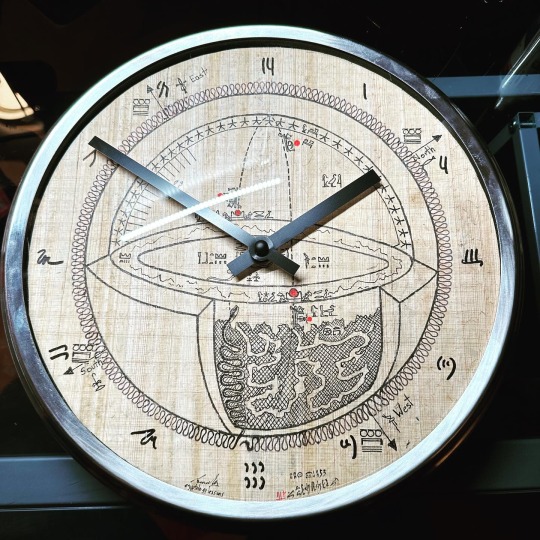

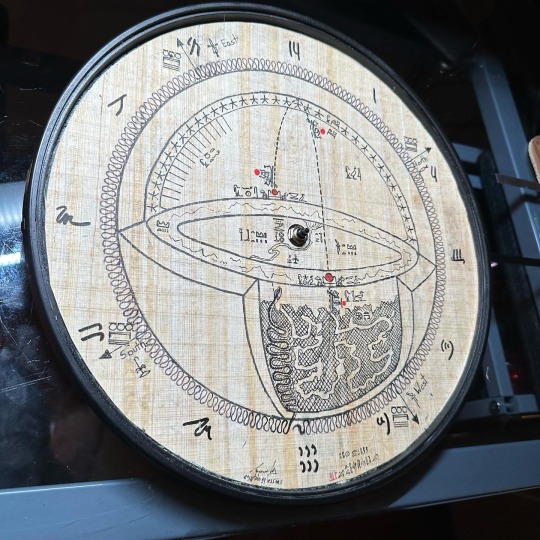





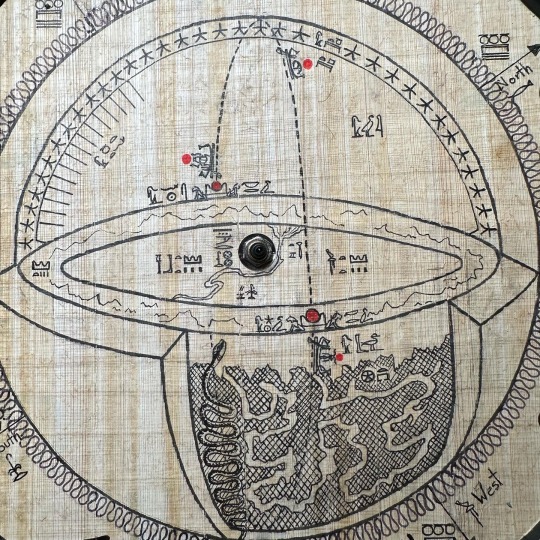

A modern recreation of the Ancient Egyptian cosmological world. The video provides details and explanation of the art, which is greated on natural papyrus paper.
Dimensions: Diameter 12”, Depth of Clock 2”
The original concept art derived from Egyptologist @Tito Vivas (Gracias/Thank you)
Photo of Tito shared by Egyptologist @elianubis (Gracias/Thank you)
𓋹𓎬𓋹𓎬𓋹𓎬𓋹𓎬𓋹𓎬𓋹𓎬𓋹𓎬𓋹𓎬𓋹𓎬𓋹𓎬𓋹𓎬𓋹𓎬𓋹𓎬𓋹𓎬𓋹𓎬𓋹
🎥 @egyptologylessons 𓋹𓊽𓋴𓆖𓎛𓇳𓎛 ©️ 𓊁𓊁𓊁𓊁𓊁𓊁𓊁𓊁𓊁𓊁𓊁𓊁𓊁𓊁𓊁𓊁𓊁
#Ancientegypt #ägypten #egyptology #egypte #egitto #egipto #이집트 #egypt #egyptologylessons #cosmology #mythology #hieroglyphs #hieratic #clock #egypte
#ancientegypt#egyptology#egypte#hieroglyphics#egyptologist#hieroglyphs#clock#cosmology#Ancient Egyptian#Ancient Egypt
24 notes
·
View notes
Text
Ooc: *Breathes*
FEATHERED SERPENTS, DOG GUARDIANS OF THE DEAD, AND JAGUARS WERE A THING FOR SOUTHEASTERN TRIBAL BELIEFS
#Researching our cosmology for work and aaaaaaa#We got distant connections with the Aztec#I knew we did with our art#But also in our ancient beliefs
6 notes
·
View notes
Text
On the Symbolism of the Ogdoad

It's been my experience that buried underneath patterns, beliefs, and interpretations there are core truths. The Greeks called them Forms or First Principles, the Egyptians knew them as the Netjeru, among the Teutons they were the Runes, and to the Hebrews they were the Sefirot. Based on my own experiences I am of the firm belief that these Principles are, in a sense, animated and alive. Being able to hear and see them takes time and sacrifice. I can say it feels like a blessing to reach out and touch even one of them.
The Netjeru are forces of nature within the spectrum of Cosmos and Chaos. They are embodied within both the physical universe and the human psyche. They are both primordial and universal, scientific and spiritual. The nature of their involvement with both objective and subjective reality far transcends that of third-dimensional human beings. The Egyptian word netjer or neter was carried on through the ages as the Coptic noute, the Latin natura, and finally the English nature.
In Egyptian cosmology, the Ogdoad were four pairs of Netjers conceptualized to represent different aspects of the primeval chaos. They were at the heart of the Hermopolitan cosmology. They were believed responsible for the inundation of the Nile and the rising of the sun. The forces of chaos were an essential part of the cosmic circuit. They were first mentioned in religious texts during the Middle Kingdom (2040-1640 B.C.E.). The original mound of creation (depicted as the Benben stone, a lotus flower containing the child Ra, or the child Ra hatching from the cosmic egg) was said to rise from the chaotic waters. Ra represents both the physical sun but also the creative principle as a whole. The names of the Ogdoad are:
Nun and Naunet (Primeval Ocean and Primeval Sky)
Kek and Kauket (Obscurity and Illumination)
Amun and Amunet (the Hidden One and the Revealed One)
Heh and Hauhet (Infinity and Boundaries)
The males were depicted as frogs or frog-headed men (as very prolific animals, frogs symbolize new life) whereas the females were serpents or serpent-headed women (often portrayed as spirals, serpents symbolize the latent creative force in the universe). The Egyptians chose well to use these animals as representations of the pre-creation state, thinking they would be comfortable in the primeval ooze. The Ogdoad are equivalent to the four fundamental interactions of the universe (the weak nuclear force, the strong nuclear force, gravity, and electromagnetism).
Nun was the primeval ocean and His consort Naunet was the sky above it. In the pre-creation state Nun was the chaotic primeval matter and Naunet was the primeval space. In the created universe Nun was what the Egyptians believed to be the watery firmament surrounding the world, similar to the Greek titan Okeanus, and in older texts, Naunet became the anti-sky which Ra must traverse every night in the Duat.
Kek and Kauket represented the awakening of the Universal Mind from the darkness enveloping the primeval ocean. Egyptians associated night with the chaotic energies and forces. Kek and Kauket were known as "the bringer-in of the light" and "the bringer-in of the night", respectively, indicating both their dominion over the hours of twilight and the dual-spiral nature of consciousness. Kek is that which is perpetually beyond the reach of the intellect and Kauket is the embodiment of continually pushing back barriers—of Opening the Way.
Amun and Amunet were Wind and Air, the dynamic elements of chaos. Creation cannot be explained from within, only from without, i.e. the Creator and the created universe are not one and the same. There must be an external force underlying creative efforts. This has been known by many cultures as “the breath of life” which animates inert or dead matter. The Egyptians knew this force as Amun, the Netjer of wind also known as the Hidden One. Amun represents the occult force underlying creation.
Heh and Hauhet symbolized the dynamic relationship between Matter and Spirit. One knows a compounded horizon, the other bears the limitless expanse of the primeval waters, knowing neither the impression of space nor time.
Most ancient cultures (as well as some that survive to this day) lived by the understanding of the cyclicality of nature, which can be observed within the succession of seasons. The universe was perceived as dynamic and animated rather than mechanistic and dead. The wisdom that many these days perceive as baseless or quaint was the result of centuries spent working the earth and observing the sky. The ancients developed mystery plays to illustrate the cosmic dance, the eternal conflict between the forces of cosmos and chaos. The mystery plays, rites, and festivals were more than just religious affairs to the ancients; they were acts of involvement with the cosmic crisis (often portrayed by the disappearance and rebirth of the sun).
The sun symbolizes cosmic order. The word "order" often sounds sterile and mechanistic but, rather, is taken to mean balance or regulation. The glaring heat of summer and the brittle cold of winter symbolically contributes to the death of the earth. From these chaotic seasons come longer days, renewed vegetation, and new generations of fauna, the cyclicality of creation playing out on the cosmic stage. Should the forces of either cosmos or chaos destroy the other, the outcome will be the same regardless of the victor. The creative principle involves a continuance of transformation through creation and destruction—an alchemy if you will. This has been depicted by many cultures as the world serpent.
The bringing of order and definition to the primeval state was not a sudden or random event but one subject to a greater form of law. The Egyptians knew this as Ma'at, the Greeks as Logos, the Teutons as Ørlög, the Hindus as Ṛta, the Zoroastrians as Asha, and the Lakota peoples as Wakan Tanka or the Great Mystery. In the Judeo-Christian tradition, it is referred to as the Word of God. Creation is not something that can be explained from within, but only from outside of it or beyond its scope; whence comes the concept of the occult or hidden force underlying creation. This is not something I consider to be a god necessarily but rather an emanation, a permeating force or principle that underlies objective existence. In the microcosm, this would be comparable to the notion of vitality or the animating principle.
Creation is an emanating, dynamic, and ongoing act as opposed to a singular, decisive act. It is the process by which undifferentiated matter, energy, and consciousness are brought to order and definition. It is the transition from subjective being to objective being, from the unconscious to the conscious. In human terms, it is the transition from an unconscious state to one of awareness. It is not the bringing forth of something out of nothing. The necessary elements already exist and the act itself is the forming and re-purposing of chaotic matter or energy into something new. To a person rousing from active sleep, their dream could be considered incredibly real even though it was the product of their unconscious mind attempting to categorize the experiences of the previous day.
Creation is inherently cyclical, continuous, and multidimensional. The experience of it is, by its very nature, transcendental (i.e. beyond oneself). The universe is not static. It is evolving on every scale and in every aspect, very much animated and alive. One of the core Hermetic teachings is that everything in the universe is composed of energy vibrating at an infinite range of frequencies, all of which are susceptible to mental influence.
Inherent in this dynamic process is the reconciliation of opposites, a practical example of which can be found in the interaction between matter and antimatter. The majority of the universe is comprised of plasma with matter and antimatter distributed throughout. When matter (e.g. a negatively-charged electron) and antimatter (a positively-charged positron) collide, they produce a violent reaction—the conversion of matter to energy in the form of an explosion. In doing so, the particles and antiparticles negate each other and return to zero mass with their total energy being redistributed into the surrounding space, transformed into gamma radiation. The universe wastes nothing.
This process was defined philosophically as the dialectic Thesis-Antithesis-Synthesis and portrayed allegorically as Unity-Scission-Reconciliation. This dialectic is observable in nature as the changing of seasons, the life cycles of flora, and the behavior of fauna. It manifests recurrently in human lives as the intricacies of relationships and personal growth, the outreaching of generations, and the evolution of customs, trends, and technology.
The Ancient Egyptians had a way of expressing such relationships and interactions. This was achieved by grouping the Netjeru into dyads, triads, tetrads, etc. These groupings were formulaic, illustrating the interaction between principal forces. For example:
Nun-Ptah-Atum
Nun: undifferentiated matter/energy
Ptah: converting potentia to dunamis
Atum: self-begotten awareness
This triad embodies the scientific basis of Creation in which the undifferentiated, inert state of matter and energy come into being as the physical universe. The Egyptians portrayed the transformative catalyst as Ptah, the patron Netjer of artisans. Ptah is portrayed with His body bound in cloth (representing the dense state of matter, the concealed potentiality underlying creation), often standing on a pedestal or seated on a throne (representing His mastery over universal laws). His hands and head are uncovered (indicating the capacity for action, expression, and intent) and He is often seen holding a staff combining the ankh, was, and djed (symbols of life, sovereignty, and stability).
I am writing a book that focuses on Nun and will occasionally post snippets of it here. Nun is one of the Netjers that I work with and I’ll be writing more about that in my Relationships With The Netjeru series. You would be surprised by the wisdom and friendship to be found in obscure forces of creation.
#kemetic paganism#kemetic#kemeticism#kemetism#egyptian gods#netjeru#egyptian paganism#egyptian polytheism#ancient egypt#ancient kemet#kemetic polytheism#ancient egyptian#ogdoad#nun#ptah#atum#amun#amunet#creative principle#hermopolitan#hermopolis#cosmology#ra#maat#ma'at
6 notes
·
View notes
Photo
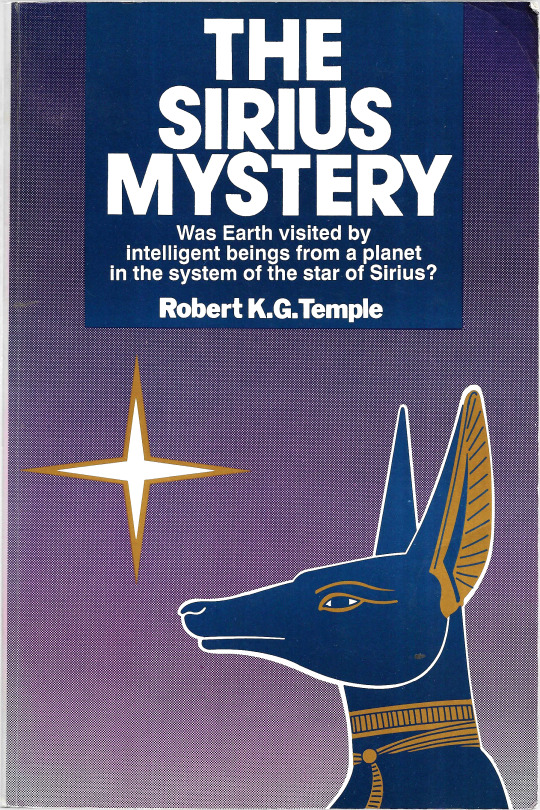
The Sirius Mystery
#sirius#dog star#ancient astronomy#ancient egypt#ancient babylon#sumerians#dogon tribe#mali#west africa#african spirituality#cosmology#books
60 notes
·
View notes
Text
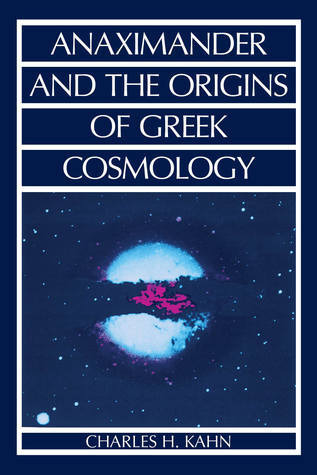
Charles H. Kahn Anaximander and the Origins of Greek Cosmology.
A classic on Anaximander and the early ancient Greek philosophy and cosmology!
3 notes
·
View notes
Video
youtube
⏳ Philo of Alexandria / Philosophy / Theology #Philo #Philosophy
"TIME IS A THING POSTERIOR TO THE WORLD. THEREFORE IT WOULD BE CORRECTLY SAID THAT THE WORLD WAS NOT CREATED IN TIME, BUT THAT TIME HAD ITS EXISTENCE IN CONSEQUENCE OF THE WORLD. FOR IT IS THE MOTION OF THE HEAVEN THAT HAS DISPLAYED THE NATURE OF TIME."
PHILO OF ALEXANDRIA
PHILO OF ALEXANDRIA WAS A HELLENISTIC JEWISH PHILOSOPHER WHO LIVED IN ALEXANDRIA, IN THE ROMAN PROVINCE OF EGYPT.
#youtube#philo#philo of alexandria#philosophy#knowledge#philosophical#philosophical quotes#theology#inna besedina#logos#ancient philosophy#middle platonism#cosmology#hellenistic judaism#philosophy of religion#wisdom#wisdom quotes#education#educational
2 notes
·
View notes
Text
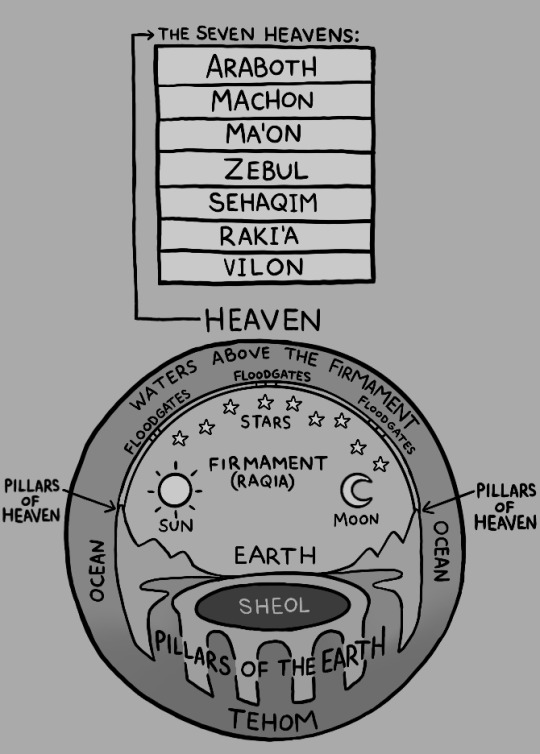
Ancient Hebrew Cosmology
#cosmology#cosmography#map#cosmos#ancient#Hebrew#mythology#hebrew mythology#sheol#heaven#earth#universe
83 notes
·
View notes
Text
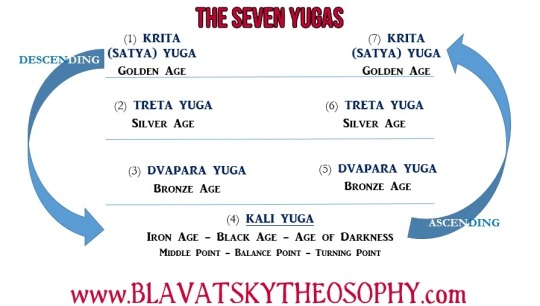
It is quite well known that Hinduism teaches the existence of four Yugas or Ages which together comprise the Maha-Yuga or “Great Age,” which is itself but an extremely minuscule and fleeting part of the entire Maha-Kalpa, the life cycle of the manifested Universe.
The names and durations assigned to the Yugas are as follows:
1st – Satya Yuga (also called Krita Yuga) – Golden Age – 1,728,000 years
2nd – Treta Yuga – Silver Age – 1,296,000 years
3rd – Dvapara Yuga – Bronze Age – 864,000 years
4th – Kali Yuga – Iron Age – 432,000 years
Total: 4,320,000 years (The Maha-Yuga)
According to Hindu tradition, we are currently in the Kali Yuga, which is said to have begun around 5,000 years ago with the death of Krishna, the great divine Teacher and Reformer who is the central figure of the Bhagavad Gita, and for whom there is evidence that he really once lived on Earth.
In the teachings of Theosophy, H. P. Blavatsky informs us in “The Secret Doctrine” that “The year of the Kaliyuga is said to have begun between the 17th and 18th of February in the year 3102 B.C.” (Vol. 2, p. 435) and clarifies that in fact “the instant of the beginning of Kali-Yuga” was “2h. 27m. 30s. a.m. of February 16th” of that year, 5,124 years ago as of 2022 (Vol. 1, p. 662).
It’s easy to work out that the Kali Yuga still has 426,876 years remaining, an almost unimaginably lengthy period of time!
But how literally are we to take these numbers? In his article titled “Cycles,” William Quan Judge shows the hidden numerical code present in the figures of the Yuga chronology.
The Satya Yuga is said to last for 1,728,000 years. Add 1+7+2+8 and the result is 18.
The Treta Yuga is said to last for 1,296,000 years. Add 1+2+9+6 and the result is 18.
The Dvapara Yuga is said to last for 864,000 years. Add 8+6+4 and the result is 18.
The Kali Yuga is said to last for 432,000 years. Add 4+3+2 and the result is 9.
Add 18+18+18+9 and the result is 63. Add those two numbers, 6 and 3, together, and the result is 9. Multiply 6 by 3 and the result is 18. Add that 1 and 8 together and the result is 9. This is undoubtedly of great significance but its real meaning has not been revealed, neither by Mr Judge nor by HPB nor by any of the Masters.
In his important book “The Ocean of Theosophy” (p. 126) Mr Judge writes that, “At the present time we are in a cycle of transition, when, as a transition period should indicate, everything in philosophy, religion and society is changing. In a transition period the full and complete figures and rules respecting cycles are not given out to a generation which elevates money above all thoughts and scoffs at the spiritual view of man and nature.”
Whilst the above figures from the chronologies of exoteric Hinduism are generally used and mentioned in the Theosophical teachings, HPB makes this statement in “The Secret Doctrine” Vol. 2, p. 67:
“Such computations as are given in Manu and the Puranas [Note: These ancient Hindu texts are the main source for the figures of the durations of Yugas, Manvantaras, Pralayas, Kalpas, etc.] – save trifling and most evidently intentional exaggerations – are, as already stated, almost identical with those taught in esoteric philosophy.”
So within those figures there are indeed some “exaggerations,” she says, albeit – for whatever reason – “intentional exaggerations” but on the whole the figures are “almost identical” with those accepted by the Gupta Vidya or Secret Doctrine or Esoteric Philosophy of the Brotherhood of Masters of Wisdom. The fact that they are almost identical and thus not identical is good reason for Theosophists to not focus on or present these numbers as if they are literal, unquestionable, wholly accurate, absolute facts, which has unfortunately been the approach in many cases. But as the true figures or numbers are not given to the public, it appears the exoteric Hindu ones are considered by the Masters to be “close enough” to use, provided that one remembers that they are not the real, literal thing. As will be seen below, HPB says the figures given for the Yugas are only “an approximate duration.”
We also have these words from “The Secret Doctrine”:
“It had been declared from the first and has been repeatedly asserted since that no Theosophist, not even as an accepted chela – let alone lay students – could expect to have the secret teachings explained to him thoroughly and completely, before he had irretrievably pledged himself to the Brotherhood and passed through at least one initiation, because no figures and numbers could be given to the public, for figures and numbers are the key to the esoteric system.” (Vol. 1, p. 164)
“The figures belonging to the Occult calculations cannot be given – as the Masters have many times declared – outside the circle of pledged chelas, and not even these can break the rules.” (Vol. 1, p. 170)
“We are not given the figures of the Great Kalpa, and are not allowed to publish those of our small Yugas, except as to the approximate duration of these.” (Vol. 1, p. 206)
“We are not taught figures which are and will remain secret with the Masters of Occult Science, as justly stated in “Esoteric Buddhism.”” (Vol. 2, p. 251)
Another good reason for not categorically “nailing it down” is because a surprisingly little known article by HPB lifts the veil to some degree on the true esoteric system, revealing that there are in fact seven Yugas, a truth which should have already presented itself to the intuition of the student of Theosophy, who knows well that all manifestation is of a septenary nature and that the golden key to understanding the mysteries of the Universe is to apply the law of correspondence and analogy. It is also made clear in “The Secret Doctrine” and elsewhere that the Hindu system as a whole (i.e. not merely on the subject of the Yugas but on virtually every subject) is generally a fourfold system, rather than sevenfold, and that while the fourfold approach can make things simpler and easier to grasp, it is not the complete truth of things but rather a condensation or compression of the sevenfold reality.
Instead of passing through the Golden Age, Silver Age, Bronze Age, Iron Age (“an age BLACK WITH HORRORS” – “The Secret Doctrine” Vol. 1, p. 645) and then starting the fourfold cycle all over again by somehow jumping from the darkest depths of the Iron Age into a new Golden Age, it appears that the Maha-Yuga actually follows the same type of involutionary and evolutionary arc as the seven rounds of the seven globes of our planetary chain. There is a gradual arc of descent, beginning at a pure, high, but relatively unconscious and unintelligent state, which eventually reaches the very lowest point to which it can go, after which there is a gradual arc of ascent, back up the same scale through which it had descended, but this time with the invaluable addition of acquired consciousness, intelligence, and soul experience. This is described as “the shadowy arc” and “the luminous arc.”
This information comes from a brief article by HPB published in January 1884 under the title “Premature and Phenomenal Growths”. One might not expect an article with such a title to contain such an important key but this is all the more reason why – as the articles on this site frequently emphasise – we should always pay very close and studious attention to everything HPB has written, for there is not one single unimportant or irrelevant sentence or paragraph in all the many thousands of pages of her writings.
Towards the end of that article, which is published today in the first volume of “H. P. Blavatsky Theosophical Articles” by Theosophy Company for the United Lodge of Theosophists, she quotes the text of what she calls “a prophecy in certain Asiatic old books.” Its content and style can be seen to be of the exact same type as the many esoteric commentaries quoted from a few years later throughout the two volumes of “The Secret Doctrine,” particularly in the second volume which is titled “Anthropogenesis.”
We have put in bold the sentence which most relates to this present subject:
“And as the fourth (race) was composed of Red-yellow which faded into Brown-white (bodies), so the fifth will fade out into white-brown (the white races becoming gradually darker). The sixth and seventh Manushi (men?) will be born adults; and will know of no old age, though their years will be many. As the Krita, Treta, Dvapara and Kali (ages) have been each decreasing in excellence (physical as well as moral) so the ascending – Dvapara, Treta, and Krita will be increasing in every excellence. As the life of man lasted 400 (years in the first, or Krita Yuga), 300 (years in Treta), 200 (years in Dvapara) and 100 (in the present Kali age); so in the next (the 6th Race) (the natural age of man) will be (gradually increased) 200, then 300 and 400 (in the last two yugas).”
This is clear enough – there is a Krita Yuga, a Treta Yuga, a Dvapara Yuga, a Kali Yuga, and then another Dvapara Yuga, another Treta Yuga, and another Krita Yuga, which closes the sevenfold cycle. This has been illustrated in the diagram at the top of this article.
One thing which is curious about the above quote is that it equates the Sixth Root Race with the ascending Dvapara Yuga or Bronze Age. This is curious seeing as “The Secret Doctrine” states in several places that the Kali Yuga will not come to an end until the end of the Sixth Root Race, meaning that the next Yuga would not begin until around the start of the Seventh Race.
Could it be, therefore, that really the Kali Yuga will end before our Fifth Root Race comes to an end?
Raghavan Iyer believed so. In his article “Involution” (first published in the December 1982 issue of “Hermes” by the Santa Barbara Lodge of the United Lodge of Theosophists) he states, “. . . the present Kali Yuga. This yuga . . . will indeed end before the completion of the present Fifth Root Race, and be followed by an ascent through the yugas towards the Satya Yuga.” Due to HPB’s “Premature and Phenomenal Growths” article being so little known, this statement would probably be considered by many as “untheosophical” whereas in fact it is completely in line with the esoteric prophecy translated therein by HPB. Iyer – apparently the only Theosophical writer to have noticed or at least commented upon the doctrine of the Seven Yugas – continues: “The four yugas may be understood in terms of a descent from the most golden age to the most decadent, followed by a reascent to a golden age that represents a spiralling spiritual advance over the starting-point of the cycle.”
Interestingly, the event known as the “Coming of Maitreya” or “Coming of the Kalki Avatar” and which HPB always speaks of as being due at the end of the Kali Yuga and its coincident close of the Sixth Root Race and start of the Seventh (see Maitreya in The Light of Real Theosophy) is indicated in her “Theosophical Glossary” entry for “Maitreya Buddha” to be due instead “during the seventh (sub) race” rather than Root Race. Why “sub” is there in brackets and why that expression is not elaborated upon by her is unknown; most likely it is because no more can be revealed than this at this present time but it should hopefully make us realise that many things may not be as “cut and dried” as we would like them to be, hence the importance of our guarding against dogmatic assertions. That “Glossary” expression could however be further evidence that the Kali Yuga is indeed going to draw to a close by, or during, the seventh sub-race of this present Fifth Root Race.
Almost nothing about how the Yugas (whether four or seven in number) relate or correspond to the Seven Root Races is divulged in the Theosophical literature, with perhaps the most notable exception being the implication in “The Secret Doctrine” Vol. 2, p. 147, that the Dvapara Yuga or Bronze Age (which preceded our Kali Yuga) began around the start of our Fifth Root Race. We would all surely admit that even if we had been given more information on these points, we would not know what to do with it.
Yet although we cannot say for definite exactly how long the Kali Yuga or any Yuga actually lasts, nor at which precise point in the Races it will end, one thing which is made very clear and definite throughout the Theosophical literature is that the closing of the first 5,000 year cycle of the Kali Yuga would be an extremely serious, important, and momentous event in the evolution of humanity. There are many references to this in many places. In “Letters That Have Helped Me” (p. 97) William Judge writes, “The present cycle, which closes Nov. 17th, 1897 – Feb. 18th, 1898, is one of the most important of any that have been.”
It is, however, only the first 5,000 years of the Kali Yuga that have come to a close, not the Kali Yuga itself.
The idea popular in the New Age Movement that the entire Kali Yuga has finished and that we are already in the Golden Age or Satya Yuga, or that the Golden Age began in 2012, is not only unphilosophical but has no basis or foundation in anything at all other than the imaginations and fantasies of psychics and “lightworkers.”
Such wishful thinking is of course entirely understandable but it will not truly help anyone. As HPB once wrote, “Has the “last age” – the Age of Iron, or Kali Yuga – closed since then? Quite the reverse, since it is shown to be in full sway just now, not only because the Hindus use the name, but by universal personal experience. … Is it this age of ours that is the promised “Golden Age” – in which neither the venom of the serpent nor of any plant is any longer lethal, and in which we are all secure under the mild sway of God-chosen sovereigns? The wildest fancy of an opium-eater could hardly suggest a more inappropriate description, if it is to be applied to our age or to any age since the year one of our era.”
On p. 377 of the first volume of “The Secret Doctrine,” HPB remarks that “It is curious to see how prophetic in almost all things was the writer of Vishnu Purana when foretelling to Maitreya some of the dark influences and sins of this Kali Yug.” She then quotes from this ancient Hindu scripture known as the Vishnu Purana, which in describing the development of the Kali Yuga says amongst many other things:
“Wealth and piety will decrease until the world will be wholly depraved. Property alone will confer rank; wealth will be the only source of devotion; passion will be the sole bond of union between the sexes; falsehood will be the only means of success in litigation; and women will be objects merely of sensual gratification. ….. External types will be the only distinction of the several orders of life; ….. a man if rich will be reputed pure; dishonesty (anyaya) will be the universal means of subsistence, weakness the cause of dependence, menace and presumption will be substituted for learning; liberality will be devotion; mutual assent, marriage; fine clothes, dignity. He who is the strongest will reign; the people, unable to bear the heavy burden, Khara bhara (the load of taxes) will take refuge among the valleys. … Thus, in the Kali age will decay constantly proceed, until the human race approaches its annihilation (pralaya). … When the close of the Kali age shall be nigh, a portion of that divine being which exists, of its own spiritual nature … shall descend on Earth … (Kalki Avatar) endowed with the eight superhuman faculties. … He will re-establish righteousness on earth, and the minds of those who live at the end of Kali Yuga shall be awakened and become as pellucid as crystal.”
In the first of the two booklets titled “Conversations on Occultism,” Mr Judge presents a conversation between himself (as “Student”) and HPB (as “Sage”) under the title “The Kali Yuga – The Present Age.” In this, the Sage says, “There is one thing peculiar to the present Kali-Yuga which may be used by the Student. All causes now bring about their effects much more rapidly than in any other or better age. A sincere lover of the race can accomplish more in three incarnations under Kali-Yuga’s reign than he could in a much greater number in any other age. Thus by bearing all the manifold troubles of this Age and steadily triumphing, the object of his efforts will be more quickly realized, for, while the obstacles seem great, the powers to be invoked can be reached more quickly.”
The Student asks, “Even if this is, spiritually considered, a Dark Age, is it not in part redeemed by the increasing triumphs of mind over matter, and by the effects of science in mitigating human ills, such as the causes of disease, disease itself, cruelty, intolerance, bad laws, etc.?”
To this comes the answer: “Yes, these are mitigations of the darkness in just the same way that a lamp gives some light at night but does not restore daylight. In this age there are great triumphs of science, but they are nearly all directed to effects and do not take away the causes of the evils. Great strides have been made in the arts and in cure of diseases, but in the future, as the flower of our civilization unfolds, new diseases will arise and more strange disorders will be known, springing from causes that lie deep in the minds of men and which can only be eradicated by spiritual living.”
This particular dialogue ends with the question, “Are there any causes, other than the spread of Theosophy, which may operate to reverse the present drift towards materialism?”
The Sage replies, “The spread of the knowledge of the laws of Karma and Reincarnation and of a belief in the absolute spiritual unity of all beings will alone prevent this drift. The cycle must, however, run its course, and until that is ended all beneficial causes will of necessity act slowly and not to the extent they would in a brighter age. As each student lives a better life and by his example imprints upon the astral light the picture of a higher aspiration acted in the world, he thus aids souls of advanced development to descend from other spheres where the cycles are so dark that they can no longer stay there.”
But the present situation is not as gloomy as one might imagine, for there are cycles within cycles, and – Theosophy says – there is great potential for a type of golden age within the Dark Age of the Kali Yuga. Such a golden age will not be the Satya Yuga but rather something else. It results from the fact that the Aquarian Age, the New Age of Aquarius, began very shortly after the 20th century began, just a few years after the second sub-cycle of the Kali Yuga was ushered in. This zodiacal or astrological Age of Aquarius will last for around 2,160 years. But that is another subject and explored in another article.
~ BlavatskyTheosophy.com ~
One thought on “The Seven Yugas”
George Muttathil
SEPTEMBER 29, 2014 AT 2:00 PM
#yoga#spirituality#theosophy#cosmology#occult#esoteric#yuga#kali yuga#vedic astrology#ancient astrology#astrology
20 notes
·
View notes
Text
A remarkable new discovery made by Peruvian archaeologists! They've uncovered two 1,400-year-old murals depicting "two-faced men" within a ceremonial hall that may refer to sacrifice and "cosmic realms" in the Moche culture.
37 notes
·
View notes
Text
"Enigmatic Wisdom Unveiled: A Journey into The Book of Enoch"

Prepare to embark on a mesmerizing odyssey through the celestial realms of ancient wisdom with "The Book of Enoch," skillfully translated by R. H. Charles. This timeless masterpiece, attributed to the biblical figure Enoch, transcends the boundaries of conventional literature, offering readers a profound glimpse into a mystical world where divine secrets unfold.
Charles's translation breathes life into the intricate narrative, guiding readers through Enoch's visionary experiences, angelic encounters, and cosmic revelations. As the pages turn, a rich tapestry of apocalyptic visions, divine judgment, and celestial mysteries unravels, capturing the essence of an ancient wisdom tradition.
The Book of Enoch, though not part of the canonical Bible, proves to be an invaluable source for understanding the spiritual landscape of its time. The text seamlessly weaves together elements of cosmology, morality, and the supernatural, creating a tapestry of thought that has captivated readers for centuries.
Charles's meticulous translation preserves the authenticity of Enoch's revelations, allowing modern readers to delve into the profound teachings that have inspired scholars, mystics, and seekers throughout history. The text grapples with themes of cosmic order, fallen angels, and the ultimate fate of humanity, offering a unique perspective on the age-old questions that continue to intrigue and perplex.
The Book of Enoch serves as a bridge between the earthly and the divine, inviting readers to contemplate the mysteries of existence and the intricate interplay between the seen and the unseen. Charles's translation, with its poetic cadence and scholarly precision, makes this ancient text accessible to contemporary readers, ensuring that the wisdom contained within continues to resonate across the ages.
In a world often dominated by the mundane, "The Book of Enoch" stands as a beacon of transcendent insight, beckoning readers to explore the boundaries of human understanding and connect with the profound truths that transcend time and tradition. This translation, with its evocative language and scholarly merit, is a key to unlocking the doors of ancient knowledge and wisdom, inviting all who dare to embark on a transformative journey through the sacred corridors of Enoch's revelations.
"The Book of Enoch," skillfully translated by R. H. Charles is available in Amazon in paperback 12.99$ and hardcover 20.99$ editions.
Number of pages: 210
Language: English
Rating: 10/10
Link of the book!
Review By: King's Cat
#Book of Enoch#Enochian literature#R. H. Charles translation#Ancient wisdom#Apocalyptic visions#Divine revelations#Celestial mysteries#Fallen angels#Cosmic order#Nephilim#Heavenly realms#Esoteric knowledge#Angelic encounters#Transcendent insight#Biblical apocrypha#Enochian cosmology#Wisdom literature#Sacred texts#Ancient mysticism#The Watchers#Astral journeys#Divine judgment#Prophetic visions#Spiritual revelation#Judeo-Christian tradition#Cosmic symbolism#Hidden knowledge#Mystical teachings#Ethical guidance#Eschatological themes
2 notes
·
View notes
Text
"It is a scientific certainty that Mars was once a much different place, with a denser atmosphere, warmer temperatures, and where water once flowed. Evidence of this past is preserved in countless surface features, ranging from river channels and alluvial deposits to lakebeds. However, roughly 4 billion years ago, the planet began to change into what we see today, an extremely cold and desiccated environment. Between all that, it is possible Mars experienced glacial and interglacial periods, which is evidenced by images like the one taken by the NASA Mars Reconnaissance Orbiter (MRO) shown above.
Evidence of glaciers on Mars includes landforms that resemble features on Earth that were shaped by the retreat of ice flows during interglacial periods. While most surface ice on Mars is confined to the polar ice caps, these landforms can be found in non-polar regions all across the planet. This feature was photographed by the High-Resolution Imaging Science Experiment (HiRISE), the main camera aboard the MRO. The full-sized image (shown below) offers a wider perspective and shows how the glacial deposit flowed downhill."
"These images are a reminder of Mars’ highly-dynamic climate, something it retains today despite all the changes it has experienced. These changes began roughly 4 billion years ago when Mars’ core region began to cool rapidly, which is believed to have arrested its global magnetic field. Henceforth, Mars’ warmer, denser atmosphere was slowly stripped away by solar wind, leading to global cooling and the gradual loss of its surface water. This led to Mars becoming the extremely cold and desiccated environment we see today."
continue reading article
(recommended reading: X X)
#mars#water#glacier#water on mars#mars climate#ancient history#solar system#space#universe#cosmology#life on mars#evolution#astronomy#science#discovery#mars seasons#mars atmosphere
3 notes
·
View notes